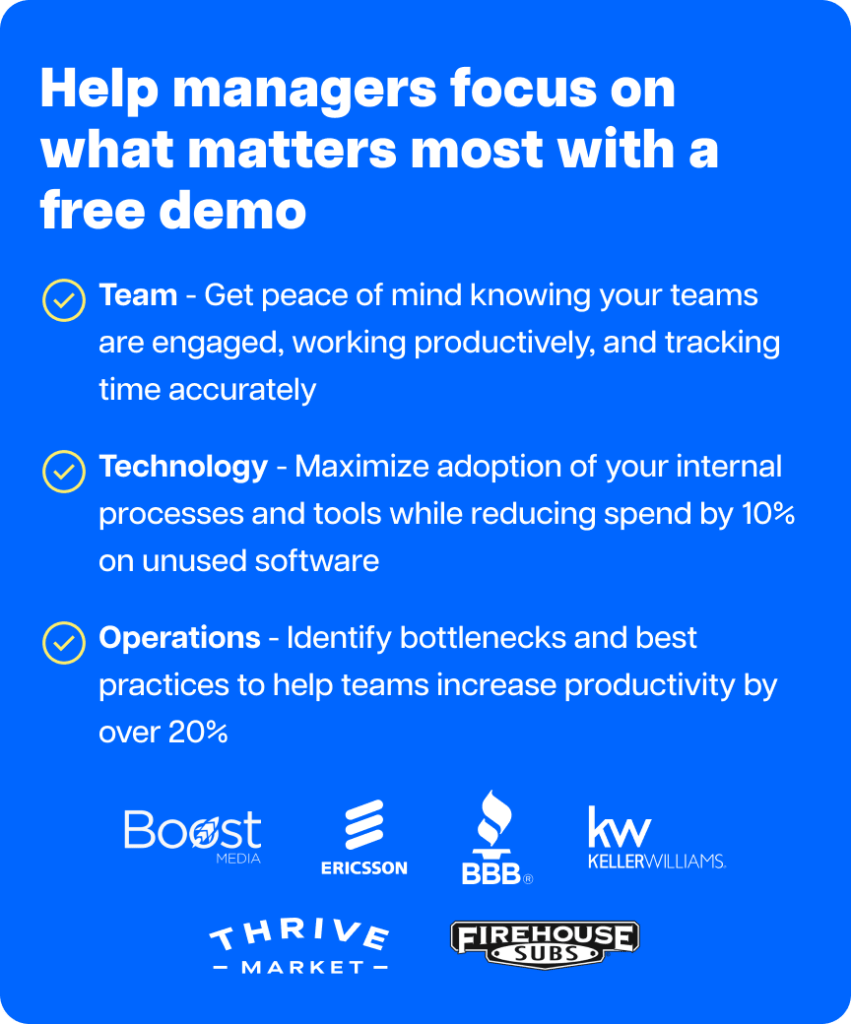Are you looking to hire a virtual assistant?
In this article, we will talk about everything you need to know about virtual assistants – what they do, how to hire, what tasks you can outsource to them, how much they cost, how to manage and more.
Or are you thinking of becoming a virtual assistant yourself? We’ve got that covered too!
What does a virtual assistant do?
A virtual assistant provides various services to entrepreneurs or businesses from a remote location. From digital marketing tasks, scheduling appointments and managing events to personal errands. You can make a virtual assistant do almost anything.
In this article we will talk about all the above topics in detail.
Here’s what we’ll cover. Use the links below to jump to the section of your choice.
- What Is A Virtual Assistant?
- Why You Need A Virtual Assistant
- What Tasks Can Virtual Assistants Do For You?
- Where To Find Virtual Assistants?
- Managing Your Virtual Assistant?
- How Much Does Hiring A Virtual Assistant Cost?
- How To Become A Virtual Assistant?
Let’s get started!
If you are managing a virtual assistant, Time Doctor will give you X-Ray vision into the tasks and projects they are working on in real time. Click here to try Time Doctor free for 14 days and increase the productivity of your virtual team.
What is a virtual assistant?
A virtual assistant is a person who provides various services to entrepreneurs or businesses from a remote location.
There are a host of things that virtual assistants can do, including:
- Social media management
- Event management
- Managing calendars, appointments and emails
- Preparing reports
- Personal tasks like booking hotels and restaurants
- Simple digital marketing tasks
It’s a never ending list!
In fact (pardon the pun here) they can do virtually anything.
Think of them as what Jarvis is to Iron Man.
They’re not there in person – but they’re still a vital part of your business.
We’re not going to go over each of those here, but we’ll touch upon the main ones later.
But why do you need a VA in the first place?
— Go back to outline —
Why you need a virtual assistant – 3 great reasons
Virtual assistants are everywhere these days. More and more people are turning to them and it looks like they’re here to stay. Here’s why you should hire one yourself.
1. Better use of your employees
Say a mid-level or senior-level employee had to choose between these two options:
- Playing an active role in spearheading growth strategies
- Preparing routine reports on a daily basis
What would they choose?
Chances are, they’d opt for option #1.
Why?
It’s more interesting and seems more important.
But that doesn’t mean you can neglect these mundane tasks like emails and finances. Your business would crumble without this boring repetitive work.
So how do you keep your in-house team happy but still get the mundane tasks done?
With virtual assistants.
They can take up most of these mundane tasks that can be done remotely.
The result?
A full-time employee (especially those you are more senior or talented) can stay focused on more pressing matters that need to be done in-person at your office.
2. Reduced costs
One of the main reasons why entrepreneurs and businesses outsource work is that it costs less.
Saving salary cost
Instead of hiring a full-time employee for a small job, you could choose to outsource it to someone at an hourly rate.
Lower pay isn’t the only way you can save money with virtual professionals though.
Saving training cost
A business owner can also save a lot when it comes to training costs.
Usually, companies have to train their in-house team on tasks and duties after they’ve cleared the hiring process.
All this costs time and money – that most companies can’t afford.
With VAs though, small business owners can hire professionals who already experts in their field.
This way, a business owner doesn’t have to waste time and money training them – they can get started right away.
3. Saves time
Another reason why small business owners turn to VAs is that it saves them a LOT of time.
We all know that time is money – especially in business.
For example, let’s say you are a small business with no HR team.
Your employees shouldn’t spend hours posting job advertisements, doing preliminary resume screening, organizing an interview process – all on a hiring process for someone at entry-level position.
Why not skip all this and get a professional to work on specific tasks instead?
With virtual assistants, this is what you’ll get:
- You’ll have verified experts that you can hire in no time
- They’re time savers as you don’t have to waste time training them
- As they can stay focused only on tasks you’ve hired them for, they’ll get the work done quicker than someone juggling multiple demands
It’s a win-win for everyone involved.
Take a look at what Liam Martin, co-founder of Time Doctor has to say about the things he’s learnt from hiring VAs for over 10 years.
— Go back to outline —
What can virtual assistants do?
I’ll be honest.
A more appropriate title here would be – “What Can’t Virtual Assistants Do For You?”
As mentioned earlier, there’s a host of things you can outsource to them.
It’s far too many to list down here, so we’re just going to cover the most common virtual assistant work by VAs.
1) Administrative work
You can hire virtual assistants to be…
*cue drumroll*
Assistants.
They can take over all the business duties that a typical administrative assistant does.
That entails:
- Diary management – Scheduling meetings and appointments
- Answering phone calls
- Basic data entry
- Organizing your to-do list and calendar
- Booking travel arrangements
Basically anything that an administrative assistant usually does.
The only difference here is that an executive assistant doesn’t have a desk in front of your office.
Apart from that – it’s pretty much the same thing as a typical administrative assistant.
2) Personal tasks
You can always hire a VA to help out with tasks in your personal life as well.
Here are a few examples:
- Organizing your personal to-do list and calendar
- Booking travel arrangements for weekend trips or vacations.
- Helping you make purchases – gifts, books, stationary, hardware and perhaps even clothes!
As a lot of these tasks don’t need to be done by someone in-person, they can easily be outsourced to a VA instead.
3) Content creation
Content writing has propelled itself to the top of the digital marketing ladder in recent years.
There’s a reason why large corporations put out blog posts often. It helps boost their search engine optimization and drive traffic to their website.
Having someone oversee this process can be a great digital marketing decision on your part.
If you have a blog that puts out new blog posts on a regular basis, you will:
- Have more people finding it on search engines
- Have more of them clicking on it and visiting your website
- Have more conversions as a result
The problem is, content creation isn’t easy. In addition to writing, there are a bunch of specific tasks like research, finding and editing images, uploading articles to your blog and so on.
That’s why it’s a good idea to outsource your blog posts to a virtual assistant. You can either outsource the ancillary tasks like images or uploads or the entire process.
For example, an increasing number of agents and brokers are using virtual assistants for their real estate marketing activities – including content creation, organizing open houses, social media and so on.
Outsourcing it to only one person ensures that each piece of content has a personal touch and doesn’t dip in quality.

4) Managing finances
There’s this general assumption among small business owners that VAs can do your taxes for you.
In an ideal world, yes they could.
But in reality, at the end of the day, they can’t do any actual accounting for you.
What they can do though, is help manage your finances.
They can maintain budgets, make purchases, and keep track of your expenses to make your finances as transparent as possible.
The result?
Avoid the last-minute rush once tax season comes around!
5) Social media management
Social media is a very important weapon in your marketing plan.
It’s where many of your potential customers are going to notice and engage with you. However, most companies appear distant and disconnected with their potential customers – your social media presence can change this.
If you don’t have the bandwidth to handle social media accounts why not outsource it to a VA?
They’ll be in charge of these specific tasks:
- Creating content to share on your social media accounts
- Scheduling posts
- Engaging with your followers
- Analyzing statistics and reports
It’s important to have someone experienced here as managing a company’s social media presence is complex. Your social media accounts need to be able to connect with people while staying relevant.
That’s why a lot of businesses turn to virtual professionals to handle macro level social media tasks.
They can keep track of what’s going viral, monitor interactions and analyze statistics to see what converts best.
You can say goodbye to worrying about why things like Tide Pods are going viral.
6) Research
Research is a core part of any company’s growth strategy.
Without some sound insights, you’ll never know how to grow.
However, a business owner can’t spend hours on research while still trying to run a small business.
When it comes to research, you need a dedicated person who’s natural language is data crunching.
They should be able to:
- Keep track of competitors’ products and services
- Analyze consumer trends
- Find formats for press releases
- Screen applications for an affiliate program
That’s a lot of research!
That’s why assigning it to someone in your team who already has other duties isn’t a great idea.
It’ll most likely be overwhelming for those team members.
That’s why small business and even large corporations are turning to VAs for research.
As they don’t have any other duties – they can stay focused on solely gathering and analyzing data to help your company.
7) Customer service
Customer Service was one of the first fields to incorporate VAs en masse.
Why?
Think about it.
Your customers aren’t interacting with you in person, so you don’t need an in-house customer executive either.
Also, as most customer service interactions are largely centered on addressing concerns that can be answered easily from a manual, you don’t need a high level of expertise here. Of course, if your VAs can’t handle an issue, it can always be escalated to a full-time employee.
Your VAs just have to spend a decent amount of time going over what it is that you offer and they’ll be prepared to answer any questions about it.
It’s the perfect fit!
What if you want your VAs to have limited access to your customers’ information?
Use a Co-browsing software like Talkative which sets up a secure way to see your customers’ screens rather than a less secure approach like screen-sharing.
8) Email management
We’ve all been there.
Opened our inbox to see an army of unopened emails staring at you.
You feel like the Millenium Falcon staring at the giant Death Star.
Responding to all those emails can be Herculean task. But it has to be done – if you just leave this repetitive work as it is, you’d be in trouble.
That’s why a lot of businesses and entrepreneurs outsource this to VAs now:
- They can sift through all your mail to weed out any spam that’s crept in
- They can answer job inquiries, general questions and follow-ups
- They can organize and filter your inbox
- They can carry out email marketing campaigns and manage email lists
The result?
Your email channel is still fully functional – without you having to do anything about it.
— Go back to outline —
Where to find virtual assistants
At this point, it’s clear that having these virtual team members can be of great assistance to you.
They can boost your productivity, take routine stuff off your hands, manage travel arrangements – the list goes on.
Now let’s get to the hiring process – How do you hire a virtual assistant?
What’s the interview process like?
This poses a unique challenge because you’re never going to be face-to-face with them.
As they’re remote workers, there’s always an element of risk associated with them.
How will I know they’ll be working diligently?
How do I verify their credentials?
Are they trustworthy?
These are all valid questions.
The first solution is to get virtual professionals from reputed sources.
The second solution is to use a time tracking tool like Time Doctor to ensure they are working diligently.
Your selection process should also be good enough to weed out unsuitable candidates. Check out this list of qualities to look for in a VA.
But let’s start with where you can find them.
Freelance marketplaces
Think of a freelance marketplace as the NBA draft – without all the hype.
You have a bunch of prospects and you select one that appeals to you.
It’s that simple.
This is what happens:
- You post a job listing on a freelance marketplace
- Freelancers can respond to that listing if the job description interests them
- You can then sift through all the replies to hire a virtual assistant that suits you
There are a few challenges though.
- You need to be extremely clear in the job description – it’s not uncommon for arguments to take place over what the requirements were once it’s payday
- Usually, there are hundreds of replies to each posting. While this gives you a large talent pool to choose from, it’s often way too much to sift through.
- As there’s no real interview process for screening, you may even have a lot of bogus applicants to go through in a virtual staff finder.
The solution is to avoid most freelancing sites and focus on the more reliable ones.
Here are a few:
1) Upwork

Firstly, there’s a thorough screening process in place for each freelancer at Upwork. What this does is weed out all the bogus candidates.
Secondly, freelancers can bid on virtual assistant jobs – either for more money or for less than the amount listed. This scares off anyone who isn’t really committed to the task.
As a result, you’ll have a smaller pool of more qualified prospects to choose from.
Upwork isn’t perfect – there are a lot of inactive profiles and it can be tedious – but it’s still a step in the right direction to grow your business.
Check out our detailed Upwork review for more information.
2) Smashing Magazine
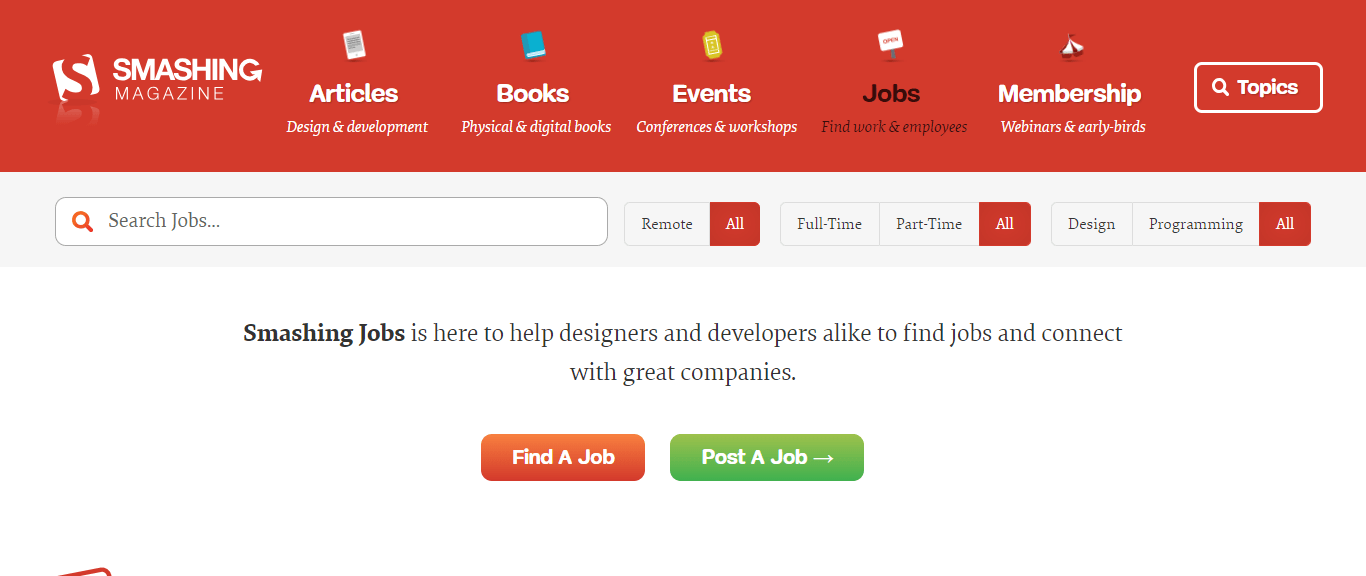
Smashing Magazine is one of the premier design marketplaces today.
As a result, you can rest assured that only the best freelancers will be listed here.
The catch is that it costs $75 to put up a listing. But if that price tag doesn’t deter you, you’ll easily find a good fit for your remote team in no time.
Virtual assistant companies
Think of virtual assistant companies as online agencies for virtual assistant jobs. Here’s a list of the top 24 virtual assistant companies to help you find the right one.
You contact these virtual assistant websites with your needs and they’ll send you a VA that’s a good fit for your company.
As you’re not sifting through applications on your own, these virtual assistant websites save you a lot of time and effort.
Additionally, as they’re coming from agencies, you can rest assured that there’s a screening process in place.
So how do you go about it?
When you go through virtual assistant companies, you don’t pay for individual virtual assistant jobs, you usually buy packages.
These are time-based and can range from 10 – 75 hours or more. You’ll have a ton of flexibility and have support along the way to make the most of your demands.
Additionally, as there’s an agency in place, they provide you with virtual assistance to handle disputes over virtual assistant work.
The downside to all this is that these virtual assistant services tend to be expensive.
This is expected because these virtual assistant websites take their own commission from their VA’s fees.
As a result, you’ll be paying more for these virtual assistant services.
Also, you’re limited to the VAs that this agency offers – in most cases they’re more than enough – but in some cases finding a good fit for your needs can be hard.
But if you don’t mind the higher price, the reliability you get from good VA agencies is more than enough to be a lifesaver on a daily basis.
We have listed a few here:
WoodBows

WoodBows is one of the best virtual assistant service providers with 98% clients repetition rate. The beauty of WoodBows is, you can get everything done by your dedicated virtual assistant at WoodBows.
They are trained in general admin tasks, inbound and outbound marketing calls, customer service, digital marketing and website design. So, you don’t have to go around and hire people individually for each one of those tasks.
Prialto
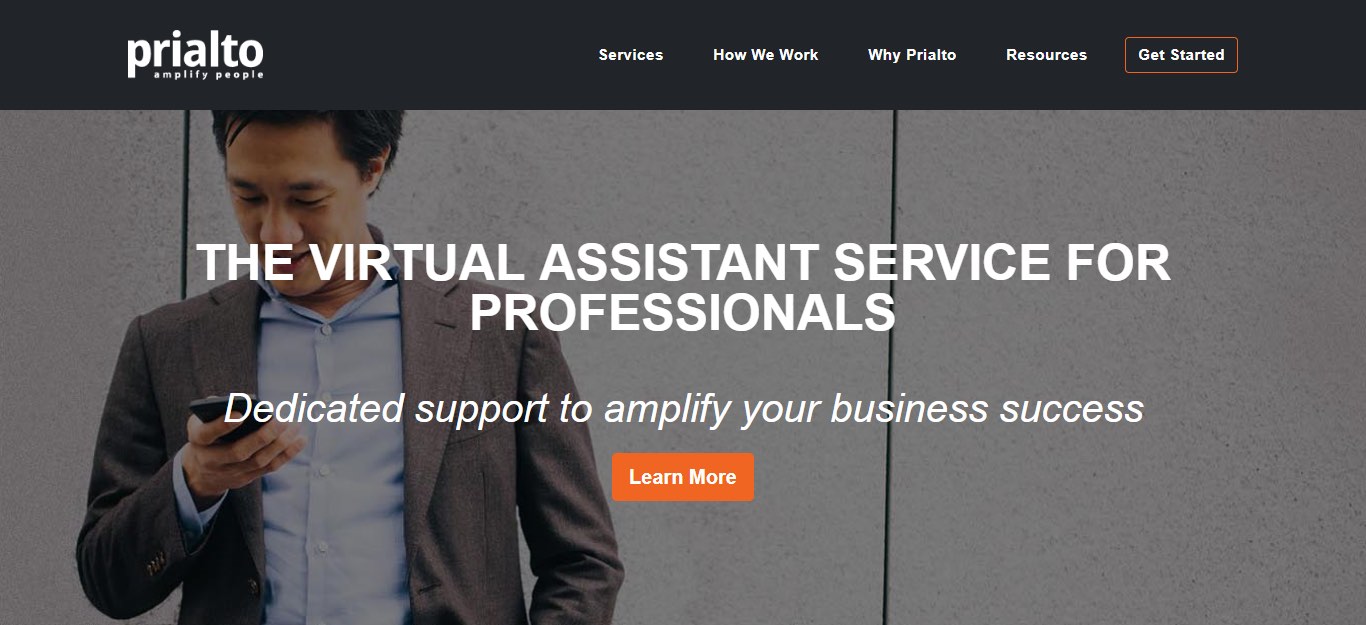
Prialto is a great agency to turn to if you want a freelance virtual assistant that can handle executive virtual assistant tasks. You can get VAs for administrative work and customer service in no time.
Serve Team

The Serve Team is a US-based company. They are a pioneer virtual assistant provider. This company is known for its 11+ years of experience. And guaranteed performance. All the team members of The Serve Team give their 100% in the tasks.
With a strong data policy in place and end-to-end data encryption. The Serve Team ensures that all the data of their client is secured. And their VAs are extensively trained to deal with all the tasks independently.
The Teams Hub

TheTeamsHub is a trusted virtual assistant provider. They partner with their clients and help them expand their business. VAs provided by TheTeamsHub are handpicked for their skills. The VAs go through training to prepare them according to industry standards.
TheTeamsHub has been ranked #1 in the various contests including a web development summit in 2020. They offer VAs who are experts in handling various tasks. With their VA you don’t need to hire dedicated support for every operation.
VASumo

VASumo is one of the leading agencies in the virtual assistant industry today.
You can get a good virtual assistant in no time that can help you with all your administrative tasks – managing inbound calls, booking travel arrangements – you name it.
Premium Help

Premium help has been in the industry for more than 10+ years. Awarded by various clients and recognized by third-party reviewers. This company provides exceptional virtual support.
They have completed 12540+ tasks since their inception. And have 1100+ happy clients. Their VAs are experts at services like website development and maintenance, SEO, digital marketing, data entry, customer support, etc.
Connect Center

Connect center has been recognized by various portals for the quality of its services. Their VAs have carved the name of this company in the market. With 12978+ happy clients, Connect center has been one of the emerging names in the industry.
The excellent services of the VAs have earned them recognition from portals like Clutch, GoodFirms, Time Doctor, etc. Connect center has over 1700+ positive reviews and their VAs can perform a number of tasks with ease and excellence.
— Go back to outline —
Managing your virtual assistants
Hiring a VA or any independent contractor can come with it’s fair share of concerns.
As you’re not interacting with them in person, there’s a lot of variables involved.
That’s why a lot of people think that managing virtual staff is a troublesome task. There are far too many things that can go wrong in a virtual office.
However, all these challenges have simple solutions.
Let’s check out the most common areas you need to manage.
Communication
As you’re not interacting with them in person, communication with VAs can be hard.
There’s only so much that regular emails can convey right?
That’s why using a communication tool like Slack, Fleep or Chanty can be helpful.
Slack can give you and your VAs a direct line of contact easily. You can share ideas, files, messages – all within seconds!

With Fleep, you can communicate effectively with your team in one common space.
You can:
- Communicate over projects
- Share files and reports
- Interact over audio and video along with screen sharing
All that in one common space!

You’ll have all you need to feel like you and your team are interacting in person as if you’re in an office.
Only this time, it’s a virtual office.
Another tool to check is Chanty.
With Chanty, you can handle all of your VA communication in one place and much more. It offers chat, audio and video calls and screen sharing. On top of this, there is also a handy project management feature so you can turn messages into tasks, making this the perfect blend of chat and project management in a single application.
Allocating tasks and monitoring progress
How do you allocate tasks to your VAs and keep track of all tasks in one place?
Use a free project management tool like ClickUp to stay on top of it all.

Using a good project management tool will help you to:
- Allocate projects and tasks with detailed descriptions and files.
- Set clear deadlines, number of hours allocated, task dependencies.
- Check the status of your projects – in list or Kanban-style views.
- Enable collaboration between your VAs and employees.
This way, you’ll know where you and your team stand at all times.
For form creation, you can use the WPForms to create an advanced form in no matter of time.
- Form Locker Addon gives restricted access to your VA to create forms and access the final results.
- Drag and drop builder feature helps to build an advanced form easily.
- Pre-made contact form templates
Trust
This is the most common challenge faced by anyone looking to hire a VA.
When you’re in an office, you have an idea of what everyone’s working on.
But when your mobile workforce is 1000 miles away, they could be up to anything right?
But there’s a simple solution.
Use a time tracking and monitoring tool like Time Doctor
With Time Doctor, you can address these concerns to make sure your virtual staff is working diligently.
Here are a few concerns you may have and how Time Doctor can address them.
How do I track the time a VA spent on a task?
As most VAs charge an hourly rate, time is literally money.
The problem is, they could always inflate the time it took them to get a larger payday.
So how do you ensure that you’re only paying for hours worked?
With Time Doctor, you can track how much time your virtual staff spends on virtual assistant tasks.
Just get a Time Doctor account and add your VAs to the team.
All they have to do is click when they’re starting a task, and the app will start tracking how much time it took them.
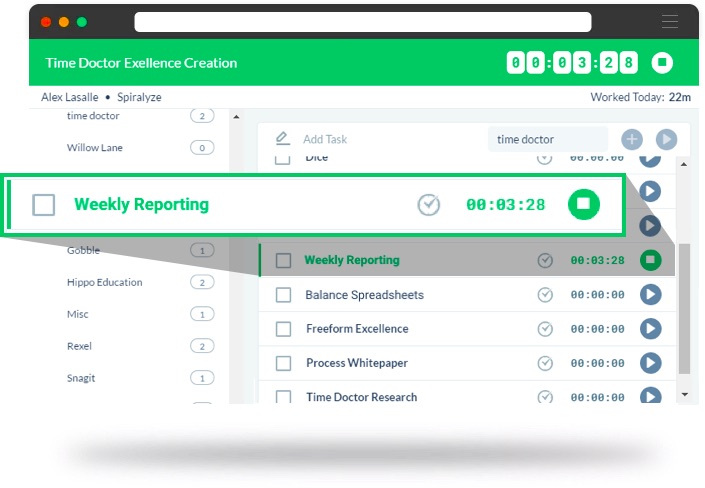
Once they’re done with the task, they can switch the timer off and you’ll have an accurate record of how long they worked.
How do I know they were actually working during those hours?
You now have a way of verifying how much time VAs spend on a task.
But how do you know that it was time spent working on virtual assistant tasks?
What if they left the timer on and went for a nap instead?
Time Doctor has an inbuilt inactivity tracker to combat this.
If there’s been no mouse or keyboard activity for three minutes, the app will assume the VA is on a break and pause the timer.
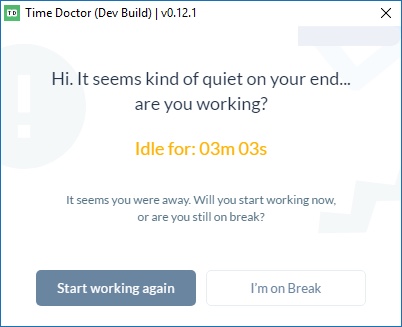
This way, you’ll only be billed for time when the employee was actively working.
How do I ensure they’re working on my task?
Your VAs could be watching cat videos on social media sites while billing you. They may even be billing you for time they spent shopping on Amazon!
That’s why Time Doctor has website monitoring capabilities.
Here’s how you go about it:
- You can set up a list of non-work related sites – such as Facebook, Twitter and so on.
- If the VA accesses any of these sites when the task timer is on, they’ll be met with a pop-up asking them if they’re still working.
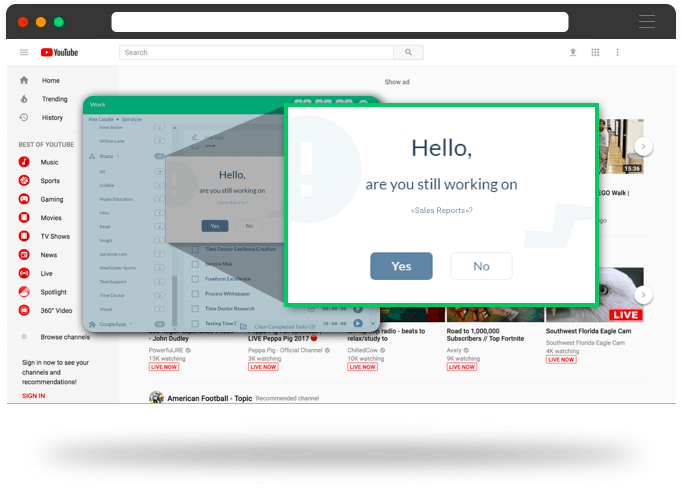
- Usually, this is a good enough deterrent to get them back to work
- Nevertheless, you’ll get a poor time use report for your VA which includes when they accessed a blacklisted site and how long they spent on it
This way, you’re only paying for hours actively worked on the task you’re paying for.
How do I maintain detailed records of my VAs’ tasks?
You’ll have access to detailed reports on all your VAs and how they’ve spent their time. This way, you can keep a check on them at all times.
Here are a few of them:
Timesheet report
Displays the total billable time your virtual professionals have spent in a day on tasks.
Timeline daily report

This is a minute-by-minute breakdown of every activity done by a virtual office assistant on a daily basis. This can easily be downloaded as an Excel sheet for records.
Project report

This gives you an idea of how long a VA worked on a particular project in a day. This is useful when you virtual office assistant works on different projects.
Web and app usage report
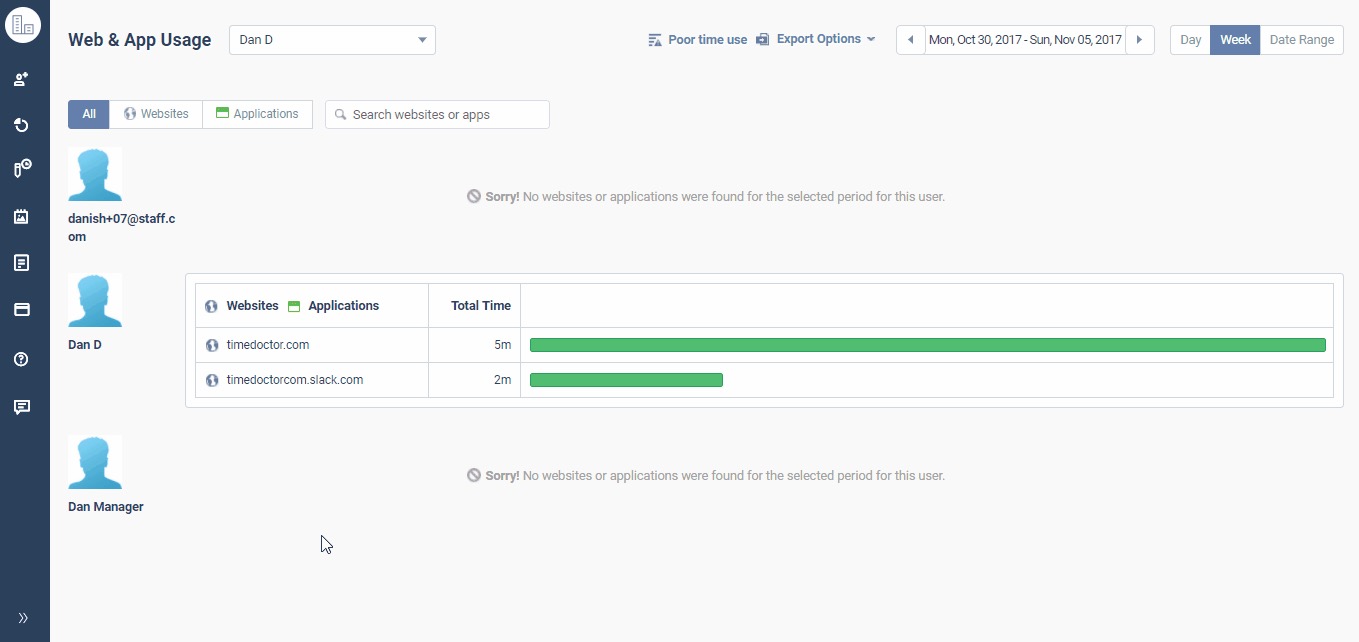
Displays every website accessed by an employee during a period along with how long they spent on each website
Poor time usage report

If an employee accesses a pre-established blacklisted site, this report records when they visited it and how long they spent there.
Attendance report

Shows you if a virtual office assistant showed up to work on time or was absent for the day.
You can also check out this list of the top virtual assistant software.
— Go back to outline —
How much do I pay a virtual assistant?
There are a few factors that come into play when it comes to determining a pay scale for your VA.
Here are a few of them.
Type of work
A lot of what you pay depends on what you’re paying for.
If it’s basic administrative tasks like managing phone calls as a personal assistant, you’d be paying around $15-25/hour.
Customer service executives handling inbound calls can earn about $25-30/hour.
When it comes to more complex skills such as digital marketing, that rate may jump to $50/hour.
To give you a better idea, check out this list from Upwork on the average hourly rate for different freelance work.
Experience level
Experience level is another important factor that comes into play here.
VAs with years of experience may charge more, but they bring a lot of expertise with them.
And with that expertise comes a level of professionalism.
That’s why opting for someone who charges a lot less but doesn’t have years of experience may be a bad idea. Sometimes that extra money for someone with years of experience can go a long way for getting reliable results.
Nationality
There’s a reason why a lot of businesses outsource to places like India and the Philippines.
It’s far cheaper hiring an independent contractor there than hiring a virtual assistant from the Western world.
The good news is that these days, you’re not compromising on quality when it comes to hiring from these countries.
You’ll still get quality work done.
You’d just be paying a fraction of the price you’d usually pay!
If you want some assistance on what to look for when hiring a virtual assistant from these countries and what daily tasks are most suited to them, check out our articles on:
Virtual assistant Philippines: How to hire, pay & more
How to hire a rockstar virtual assistant in India: Tips + tricks
How to pay a virtual assistant
When you’re going through agencies, there’s usually a payment process in place.
It’s not uncommon for these platforms to have their own payment gateways to make transactions.
You’ll pay the company and they’ll in turn pay the VA.
But what if you don’t go through one of these agencies?
What if you hired someone independently?
What do you do then?
1. Always pay after the job is done
Never pay a VA in advance.
It’s remote working 101.
If they already have the money with them, there’s no incentive to get the job done.
That’s why you always pay after the job is done.
Sometimes, they may ask you for a partial payment in advance.
While this is fine in some cases, I’d still avoid taking that option unless the nature of the work requires it. You still have no guarantee that your job will be done after that.
They could just take that advance and leave you hanging.
2. Use an established payment method
When paying remote employees, it’s very important to use a widely recognized payment method.
Here are the reasons why:
- They’re trustworthy – so you know your money isn’t going anywhere other than where it should
- Currency conversions here are far more reliable
- There’s a lot more transparency with regard to fees and surcharges
- As these are known companies, the chances of your VA having an account with them is higher
Here are the 3 best options you have:
Paypal

Paypal is one of the oldest active payment services today.
It was formed in 1998 and is one of the most commonly used platforms for international transactions.
The good
- Nobody comes close to the reach that Paypal gives you.
- It supports a ton of currencies from a lot of different countries.
- As such, you won’t have much difficulty transferring funds anywhere in the world.
- Additionally, you don’t need to set up an account to start using it (if you’re using it on a regular basis, we recommend you do set up one though).
The bad
- PayPal is notorious for the additional fees it charges on transactions.
- They charge 0.3% to 7.4% on all transactions – not including a currency conversion fee!
- If that wasn’t enough, the VAs bank may levy an additional charge on any incoming PayPal transactions.
- That’s why a lot of VAs don’t like using PayPal – they lose too much from these charges.
Wise, formerly TransferWise

Formed in 2011, Wise, formerly TransferWise is a relatively new player in the field that’s making big waves.
Why?
It solves PayPal’s biggest problem.
The good
The reason why people are shifting to Wise is because of its low rates. You only pay the mid-market exchange rate and the currency fee.
That’s it!
Registration is free of charge and so is your first transaction!
The bad
The problem with Wise is it’s reach – or lack thereof. It supports only 49 countries (It does support India and the Philippines though).
So if your VA is from an unsupported country then it’s probably a good idea to go with another platform.
Payoneer
Payoneer was established in 2005 and has the distinction of having the former president of VISA and former CEO of SWIFT on it’s board.
It’s no surprise that it’s one of the most trusted payment options out there.
The good
Payoneer supports over 200 countries and 150 different currencies! This way, there’s no danger of your VA’s preferred currency not being supported.
They charge a small currency conversion margin on every transfer. And if you pay via credit card, they charge 3.5% in many regions.
The bad
Payoneer payments take upto 3 weeks to get credited depending on the payment mode.
— Go back to outline —
How to become a virtual assistant

Thinking of becoming a virtual assistant?
The VA business is a great option for anyone looking for some flexibility in their lives.
The idea of being your own boss and spending more time with your family is a now a reality for many. That’s why more and more people are taking up VA jobs these days to become self-employed people.
You even have organizations like the International Virtual Assistants Association to safeguard your rights as a VA.
Since you’re dictating what work you take on – you’re pretty much your own boss!
As you’re free to work remotely, you can work from anywhere in the world as long as you have access to a high-speed internet connection.
You could be working:
- With the Eiffel Tower in the background
- On the sunny beaches of Bali
- Among the snow capped mountains of the Alps
You could even start your own VA business to make a little more money on the side.
The choice is yours!
But before you jump straight into a virtual assistant business, there are a few things you need to keep in mind.
Let’s go over some of them.
1. Determine what you’re offering
If you have read the earlier section, you already have an idea of what kind of tasks companies like to outsource to VAs.
The next step is determining which of them suits your skill set best.
Worked in customer service for an ecommerce store earlier? Than you might be perfect as a customer support VA.
Have communication skills? Try opting for social media management or managing inbound calls.
Been a personal assistant in large corporations earlier? Your skill set may suited to administrative work
It’s vital to clearly define what skills you’re good at and what you’ll provide to employers.
If you don’t clearly state what you’ll provide ,most people will overlook you in favour of a less qualified candidate that meets their job description requirements to the tee.
So remember, start off by defining what your skill set is and how it can help.
2. Choose your business structure
Your next step should be determining what your virtual assistant business structure is.
Are you going to be a full-time worker?
Are you just doing this on the side to earn a little more money?
This is important because it will determine the kind of daily tasks you’ll be able to take on.
If your VA business is going to be part-time, taking up a tasks like managing phone calls or customer service isn’t the best option.
You’re probably more suited to basic administrative tasks, preparing reports, or maybe even content writing.
What this does is ensure that you don’t bite off more than you can chew.
This way, you won’t be left with a series of daily tasks you have no chance of completing before a deadline.
3. Choose your pay
One of the benefits of a virtual assistant business is that you set your own salary.
There are a few things you need to remember though:
- You’re not a full-time employee – you’re an independent contractor. If you’re in the United States, you’re going to have to likely pay a self-employment tax as a result
- There are no benefits involved here – no medical, dental, 401k,etc
- You’re going to have overheads like web maintenance, renting office space and a high-speed internet connection
Remember to set your pay with these factors in mind.
A good way to start is to charge about 25% more than you would for the task in a regular job. That should be enough to cover most of these overheads.
With that being said, it’s still a good idea to look at average rates on freelancer sites to give you a better idea what virtual assistants work pays.
4. Set up a website
Now you may be wondering,
“If I’m just going to put up my profile on freelance marketplaces, why do I need a website?”
And you’d be right. You don’t need a website to be a VA.
But if you’re serious about taking this up as a professional business, it’s a good idea if you did.
Why?
It allows you to look more professional.
And in the virtual assistant industry, professionalism = reliability.
The more reliable you seem, the higher the chances are that you’re hired.
Additionally, having a website gives other people a point of reference.
Maybe they saw some of your freelance work somewhere and wanted to reach out.
With a website, they’ll have all the information they need to make an informed choice.
Luckily, it’s easier than ever to set up a website now. You can even use an AI website builder to build a website for you.
Here’s a handy guide from Wordpress on how you can go about it.
5. Network
Networking is an essential component of being a VA.
You’ll need to build connections in the virtual assistant industry if you want to be hired there.
Here’s how you go about it:
- Identify your field – You’ll need to know where your prospective employers are before setting up meetings with them.
- Look for prospects in that field – Once you’ve identified your field, look for good prospects there – look for a small business that’s open to outsourcing – businesses that in your opinion, could use your virtual assistant services
- Build your social media presence – Use social media to your advantage. Like and share posts on Twitter and Linkedin by your potential clients to get yourself noticed before formally pitching to them
- Pitch to potential clients regularly – Once you’re confident of being on their radar, go ahead and set virtual meetings with these companies – outline what it is you do and how it can benefit them.
- Offer a trial period – Your first client may be skeptical of outsourcing. To combat this, on your first time working with them, give clients a trial period to test out the waters.
You’ll build a layer of trust to cement a long term relationship with potential clients by doing so.
6. Apply to freelance marketplaces
You may be wondering why I left this for last.
Especially since there was an entire section on it earlier.
That’s because, while freelance marketplaces are still useful, there’s far too many people there to truly stand out. You’ll be one among the thousands of people employers are looking at for a job.
Building a website and making meaningful connections with potential customers is a much better mantra for long term success.
With that being said, not everyone has the means to take that approach.
In that event, freelancer websites are still an incredibly useful springboard for bigger things to come your way.
— Go back to outline —
Conclusion
Taking the help of virtual assistant to become more productive and grow your business is no longer a rarity – it’s close to becoming a necessity.
Having a go-to person for pretty much all your needs is a great assistance to any individual or business.
And if you want a powerful tool to manage your virtual assistants, you have tools like Time Doctor. To see how Time Doctor can help you manage your VAs more easily, why not sign up for the free trial?

Andy is a technology & marketing leader who has delivered award-winning and world-first experiences.

